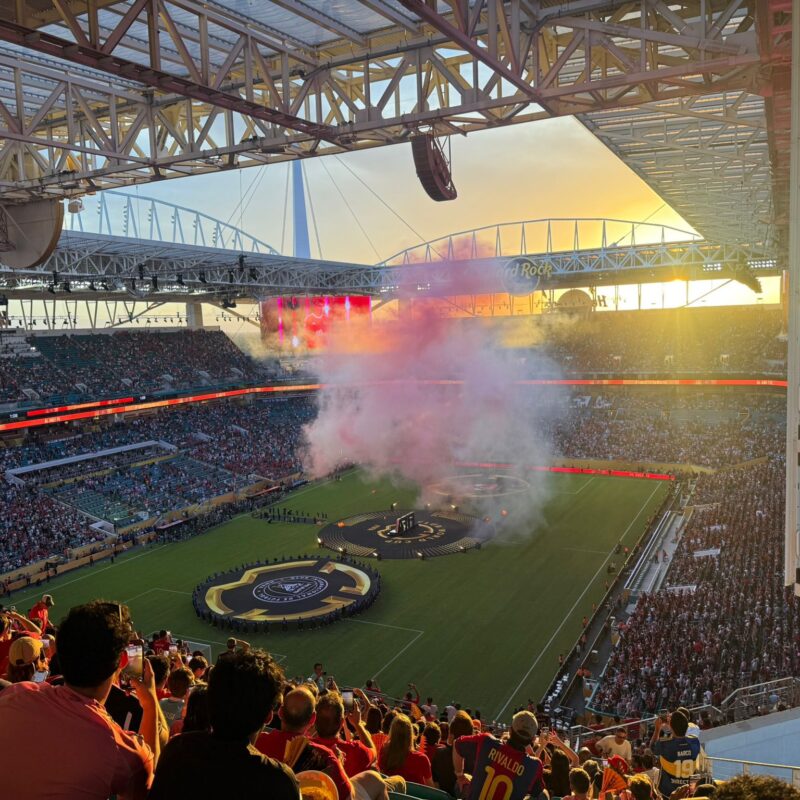
Focus on the Football, not Fireworks: How FIFA Can Get People to Care About the Club World Cup
July 14, 2025
In the sweltering heat of a Miami summer evening, I found myself watching the Al Ahly and Inter Miami players enter the field in American-sports style one-by-one formation, to sound of fireworks and “Desire” by Robbie Williams; the official Club World Cup walkout song recorded specifically for the tournament. Had the 22nd player to enter the field not been Lionel Messi, it would have been a very awkward way to kick-off what FIFA see as a new era of club football.
Ultimately, Messi was why we were all there. His presence and the hasty slashing of ticket prices saved some blushes for FIFA, creating a respectable attendance and atmosphere on opening night. However, just days later, myself and a handful of fellow Chelsea supporters combined with LA FC fans and Atalanta locals to fill a quarter of the 80,000 seater Mercedes Benz Arena. Later that week, the South African side Mamelodi Sundowns beat South Korean outfit Uslan HD in Orlando in front of a meagre 3,500 supporters.
Turning a minor competition into a major spectactle
FIFA has thrown a lot at attempting to rebrand what is to most is a minor competition into the pinnacle of club football. They’ve offered lucrative prize money to participants, essentially forcing clubs to play their best players. They’ve invested in influencers, such as the popular streamer iShowSpeed partaking in various media and halftime entertainment, and iconic boxing announcer Michael Buffer read out the teams in the semi-final match between Chelsea and Flumiense. And yet, bar some exceptions, stadiums were barely half full, even with ticket prices slashed by 97% for some matches.
Trying to win over the mega fans
The problem FIFA faces is that the hardcore football fan cares little for the “matchday experience” and instead cares more about intangibles money can’t buy: tradition, prestige and a lifelong following of a club and sport. This is also what entices casual fans into the sport, the chance to sample the partisan, passionate atmospheres which have forged through years of history, rivalries and storylines. Something this competition simply didn’t have. It’s no surprise that games involving South American clubs, to whom this competition already was perceived as the highest club honour, were far more competitive, highly energised and tense. While it wasn’t the result I wanted, experiencing Flamengo beat Chelsea in Philadelphia actually felt like a game people cared about, rather than one FIFA told us we should care about.
What happens on the pitch can matter the most
Despite failure to get fans in stands, the tournament quietly delivered some great moments on the pitch. European Champions PSG lost to Botafogo, Manchester City were knocked out in a thrilling 4-3 defeat to Al Hilal, Lionel Messi dazzled as Inter Miami shocked Porto and semi-professional side Auckland City managed to draw with Argentinian giants Boca Juniors. These results and match-ups have given the competition a charming novelty. With the Champions League and World Cup constantly expanding, there’s a sense that the same clubs and nations are playing each other on loop.
By offering a mix of sides who would never usually play each other and the chance to see clubs in the unfamiliar format of tournament football, it’s a refreshing change of pace for those suffering from football fatigue. The additional exposure and prize money will also go a long way to providing sporting and commercial growth of the non-European club game.
The first expanded Club World Cup has not been what FIFA envisioned, and the fact there’s talks of expanding it further suggests they don’t even realise what’s wrong with it. The competition needs to grow naturally, forming its own identity through iconic moments and matches, not through trying to artificially buy prestige with over the top marketing and promotion. There’s life on the pitch to show this is possible, however whether FIFA will let it do so, is yet to be seen.